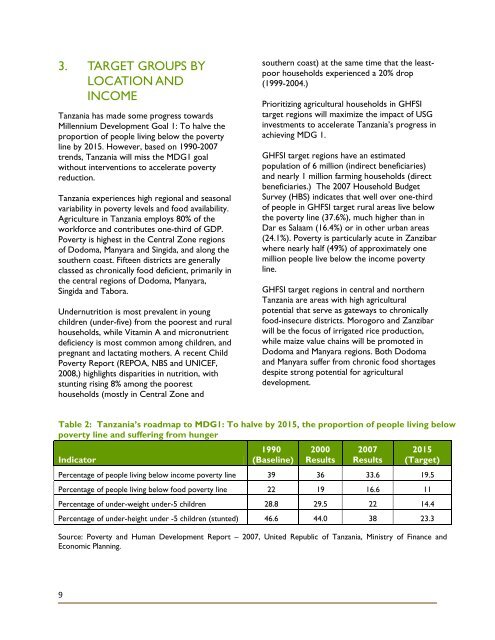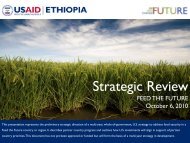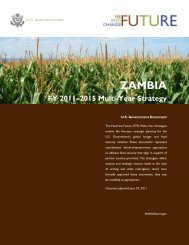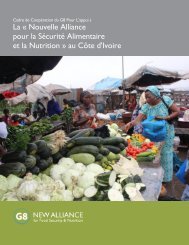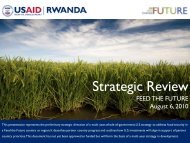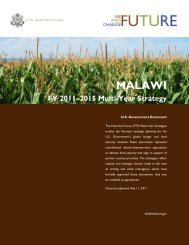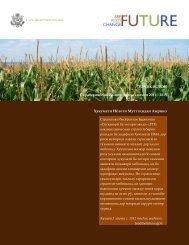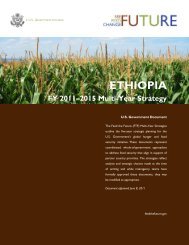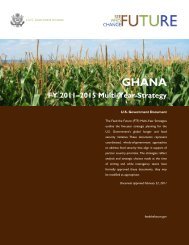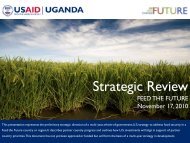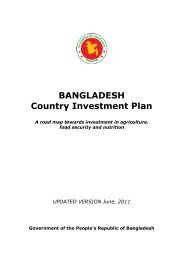Feed the Future FY 2010 Implementation Plan, Tanzania
Feed the Future FY 2010 Implementation Plan, Tanzania
Feed the Future FY 2010 Implementation Plan, Tanzania
- No tags were found...
You also want an ePaper? Increase the reach of your titles
YUMPU automatically turns print PDFs into web optimized ePapers that Google loves.
3. TARGET GROUPS BYLOCATION ANDINCOME<strong>Tanzania</strong> has made some progress towardsMillennium Development Goal 1: To halve <strong>the</strong>proportion of people living below <strong>the</strong> povertyline by 2015. However, based on 1990-2007trends, <strong>Tanzania</strong> will miss <strong>the</strong> MDG1 goalwithout interventions to accelerate povertyreduction.<strong>Tanzania</strong> experiences high regional and seasonalvariability in poverty levels and food availability.Agriculture in <strong>Tanzania</strong> employs 80% of <strong>the</strong>workforce and contributes one-third of GDP.Poverty is highest in <strong>the</strong> Central Zone regionsof Dodoma, Manyara and Singida, and along <strong>the</strong>sou<strong>the</strong>rn coast. Fifteen districts are generallyclassed as chronically food deficient, primarily in<strong>the</strong> central regions of Dodoma, Manyara,Singida and Tabora.Undernutrition is most prevalent in youngchildren (under-five) from <strong>the</strong> poorest and ruralhouseholds, while Vitamin A and micronutrientdeficiency is most common among children, andpregnant and lactating mo<strong>the</strong>rs. A recent ChildPoverty Report (REPOA, NBS and UNICEF,2008,) highlights disparities in nutrition, withstunting rising 8% among <strong>the</strong> pooresthouseholds (mostly in Central Zone andsou<strong>the</strong>rn coast) at <strong>the</strong> same time that <strong>the</strong> leastpoorhouseholds experienced a 20% drop(1999-2004.)Prioritizing agricultural households in GHFSItarget regions will maximize <strong>the</strong> impact of USGinvestments to accelerate <strong>Tanzania</strong>’s progress inachieving MDG 1.GHFSI target regions have an estimatedpopulation of 6 million (indirect beneficiaries)and nearly 1 million farming households (directbeneficiaries.) The 2007 Household BudgetSurvey (HBS) indicates that well over one-thirdof people in GHFSI target rural areas live below<strong>the</strong> poverty line (37.6%), much higher than inDar es Salaam (16.4%) or in o<strong>the</strong>r urban areas(24.1%). Poverty is particularly acute in Zanzibarwhere nearly half (49%) of approximately onemillion people live below <strong>the</strong> income povertyline.GHFSI target regions in central and nor<strong>the</strong>rn<strong>Tanzania</strong> are areas with high agriculturalpotential that serve as gateways to chronicallyfood-insecure districts. Morogoro and Zanzibarwill be <strong>the</strong> focus of irrigated rice production,while maize value chains will be promoted inDodoma and Manyara regions. Both Dodomaand Manyara suffer from chronic food shortagesdespite strong potential for agriculturaldevelopment.Table 2: <strong>Tanzania</strong>’s roadmap to MDG1: To halve by 2015, <strong>the</strong> proportion of people living belowpoverty line and suffering from hungerIndicator1990(Baseline)2000Results2007Results2015(Target)Percentage of people living below income poverty line 39 36 33.6 19.5Percentage of people living below food poverty line 22 19 16.6 11Percentage of under-weight under-5 children 28.8 29.5 22 14.4Percentage of under-height under -5 children (stunted) 46.6 44.0 38 23.3Source: Poverty and Human Development Report – 2007, United Republic of <strong>Tanzania</strong>, Ministry of Finance andEconomic <strong>Plan</strong>ning.9


